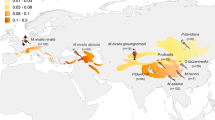Abstract
A recent study shows that the expression of pheomelanin-based coloration in barn owls follows a continuous gradient across Europe as a result of local adaptation. The selective pressures that promote local adaptation remain, however, unknown. Here we hypothesize and test that natural radioactivity levels follow a similar spatial gradient to that of pheomelanin-based color in Europe and thus represents a potential selective pressure. The rationale is that the production of pheomelanin consumes glutathione (GSH), a key intracellular antioxidant, and that GSH is particularly susceptible to ionizing radiation, which depletes antioxidants. As predicted, the intensity of pheomelanin-based coloration in 18 populations of barn owls was negatively associated with terrestrial γ-dose rates across Europe. Therefore, we propose that natural selection acts against barn owls that present the molecular basis to produce large amounts of pheomelanin in those populations that are exposed to high levels of natural radioactivity, as in these populations individuals would require higher antioxidant resources to combat oxidative stress. This is the first time that natural radioactivity levels are related to the expression of a phenotypic trait.


Similar content being viewed by others
References
Antoniazza S, Burri R, Fumagalli L, Goudet J, Roulin A (2010) Local adaptation maintains clinal variation in melanin-based coloration of European barn owls (Tyto alba). Evolution 64:1944–1954
Asch K (2005) IGME 5000: 1: 5 Million international geological map of Europe and Adjacent Areas–final version for the internet. BGR, Hannover. Available from http://www.bgr.de/karten/igme5000/downloads.htm (accessed January 2011)
Benedetto JP, Ortonne JP, Voulot C, Khatchadourian C, Prota G, Thivolet J (1981) Role of thiol compounds in mammalian melanin pigmentation. Part I. Reduced and oxidized Glutathione. J Invest Dermatol 77:402–405
Bristow Q (1978) The application of airborne gamma-ray spectrometry in the search for radioactive debris from the Russian satellite COSMOS 954. Curr Res B Geol Surv (Canada Paper) 78-1B:151–162
Bump EA, Brown JM (1990) Role of glutathione in the radiation response of mammalian cells in vitro and in vivo. Pharmacol Therapeut 47:117–136
Congiu L, Chicca M, Pilastro A, Turchetto M, Tallandini L (2000) Effects of chronic dietary cadmium on hepatic glutathione levels and glutathione peroxidase activity in starlings (Sturnus vulgaris). Arch Environ Con Tox 38:357–361
Cordeiro AR, Marques EK, Veiga-Neto AJ (1973) Radioresistance of a natural population of Drosophila willistoni living in a radioactive environment. Mutat Res 19:325–329
Dauwe T, Eens M (2008) Melanin- and carotenoid-dependent signals of great tits (Parus major) relate differently to metal pollution. Naturwissenschaften 95:969–973
Eye4Software BV (2009–2010) Available from http://www.eye4software.com/. Accessed January 2011
Fargallo JA, Laaksonen T, Korpimäki E, Wakamatsu K (2007) A melanin-based trait reflects environmental growth conditions of nestling male Eurasian kestrels. Evol Ecol 21:157–171
Forster L, Forster P, Lutz-Bonengel S, Willkomm H, Brinkmann B (2002) Natural radioactivity and human mitochondrial DNA mutations. Proc Natl Acad Sci USA 99:13950–13954
Galván I, Alonso-Alvarez C (2008) An intracellular antioxidant determines the expression of a melanin-based signal in a bird. PLoS ONE 3:e3335
Galván I, Alonso-Alvarez C (2009) The expression of melanin-based plumage is separately modulated by exogenous oxidative stress and a melanocortin. Proc R Soc B 276:3089–3097
Galván I, Solano F (2009) The evolution of eu- and pheomelanic traits may respond to an economy of pigments related to environmental oxidative stress. Pigment Cell Melanoma Res 22:339–342
Galván I, Bijlsma RG, Negro JJ, Jarén M, Garrido-Fernández J (2010) Environmental constraints for plumage melanization in the northern goshawk Accipiter gentilis. J Avian Biol 41:523–531
Galván I, Mousseau TA, Møller AP (2011) Bird population declines due to radiation exposure at Chernobyl are stronger in species with pheomelanin-based coloration. Oecologia 165:827–835
Hõrak P, Sild E, Soomets U, Sepp T, Kilk K (2010) Oxidative stress and information content of black and yellow plumage coloration: an experiment with greenfinches. J Exp Biol 213:2225–2233
Isaksson C, Örnborg J, Stephensen E, Andersson S (2005) Plasma glutathione and carotenoid coloration as potential biomarkers of environmental stress in great tits. EcoHealth 2:138–146
Kawecki TJ, Ebert D (2004) Conceptual issues in local adaptation. Ecol Lett 7:1225–1241
Mateo R, Beyer WN, Spann J, Hoffman D, Ramis A (2003) Relationship between oxidative stress, pathology, and behavioral signs of lead poisoning in mallards. J Toxicol Environ Health A 66:1371–1389
Meyskens FL, Buckmeier JA, Mcnulty SE, Tohidian NB (1999) Activation of nuclear factor-kappa B in human metastatic melanoma cells and the effect of oxidative stress. Clin Cancer Res 5:1197–1202
Navarro J, Obrador E, Pellicer JA, Asensi M, Viña J, Estrela JM (1997) Blood glutathione as an index of radiation-induced oxidative stress in mice and humans. Free Radic Biol Med 22:1203–1209
Neyfakh EA, Alimbekova AI, Ivanenko GF (1998) Radiation-induced lipoperoxidative stress in children coupled with deficit of essential antioxidants. Biochemistry (Moscow) 63:977–987
Ozeki H, Ito S, Wakamatsu K, Ishiguro I (1997) Chemical characterization of pheomelanogenesis starting from dihydroxyphenylalanine or tyrosine and cysteine. Effects of tyrosinase and cysteine concentrations and reaction time. Biochim Biophys Acta 1336:539–548
Poston JP, Hasselquist D, Stewart IRK, Westneat DF (2005) Dietary amino acids influence plumage traits and immune responses of male house sparrows, Passer domesticus, but not as expected. Anim Behav 70:1171–1181
Price TD, Qvarnström A, Irwin DE (2003) The role of phenotypic plasticity in driving genetic evolution. Proc R Soc B 270:1433–1440
Riley PA (1994) Free radicals in biology: oxidative sress and the effects of ionizing radiation. Int J Radiat Biol 65:27–33
Roulin A, Dijkstra C (2003) Genetic and environmental components of variation in eumelanin and phaeomelanin sex-traits in the barn owl. Heredity 90:359–364
Roulin A, Almasi B, Rossi-Pedruzzi A, Ducrest A-L, Wakamatsu K, Miksik I, Blount JD, Jenni-Eiermann S, Jenni L (2008) Corticosterone mediates the condition-dependent component of melanin-based coloration. Anim Behav 75:1351–1358
Sanderson DCW, McLeod JJ, Ferguson JM (2001) A European bibliography on airborne gamma-ray spectrometry. J Environ Radioact 53:411–422
Selmi S, Boulinier T (2001) Ecological biogeography of Southern Ocean Islands: the importance of considering spatial issues. Am Nat 158:426–437
Soltaninassab SR, Sekhar KR, Meredith MJ, Freeman ML (2000) Multi-faceted regulation of γ-glutamylcysteine synthetase. J Cell Physiol 182:163–170
Sperati A, Abeni DD, Tagesson C, Forastiere F, Miceli M, Axelson O (1999) Exposure to indoor background radiation and urinary concentrations of 8-hydroxydeoxyguanosine, a marker of oxidative DNA damage. Environ Health Perspect 107:213–215
Szegvary T, Conen F, Stöhlker U, Dubois G, Bossew P, de Vries G (2007) Mapping terrestrial γ-dose rate in Europe based on routine monitoring data. Radiat Meas 42:1561–1572
Wu G, Fang YZ, Yang S, Lupton JR, Turner ND (2004) Glutathione metabolism and its implications for health. J Nutr 134:489–492
Acknowledgments
We thank Xabier Vázquez Pumariño for early discussions on natural radioactivity in Galicia, NW Spain. Ulrich Stöhlker kindly allowed us to use his map of radiation levels in Europe. I.G. was supported by a Marie Curie Intra-European Fellowship of the European Community (PIEF-GA-2009-252145). Financial support to C.A.-A. was obtained from the Spanish Ministry of Science and Innovation (project CGL2009-10883-C02-02) and from Junta de Comunidades de Castilla-La Mancha (project PII1I09-0271-5037). John A. Endler, Andrew Hendry and two anonymous referees made useful suggestions that improved the manuscript.
Author information
Authors and Affiliations
Corresponding author
Electronic supplementary material
Below is the link to the electronic supplementary material.
Rights and permissions
About this article
Cite this article
Galván, I., Alonso-Alvarez, C. Natural radioactivity can explain clinal variation in the expression of melanin-based traits. Evol Ecol 25, 1197–1203 (2011). https://doi.org/10.1007/s10682-011-9480-z
Received:
Accepted:
Published:
Issue Date:
DOI: https://doi.org/10.1007/s10682-011-9480-z




